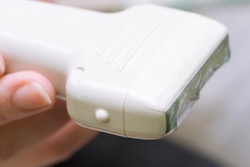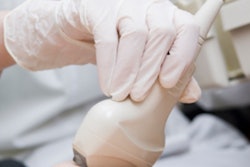
Bedside ultrasound is more sensitive than chest x-ray for identifying pulmonary edema in patients presenting with dyspnea, according to a study published in the April issue of the Journal of Ultrasound in Medicine.
And the modality's greater sensitivity isn't its only benefit, wrote a team led by Dr. William Wooten of Mount Carmel Health System in Columbus, OH.
"Bedside ultrasound appears to offer several advantages over chest radiography in the workup of patients with dyspnea beyond its superior sensitivity in the diagnosis of pulmonary edema," the team wrote. "First, bedside ultrasound exposes the patient to less radiation. Second, imaging costs to payers may be reduced."
Chest x-ray has been the commonly used imaging modality to assess patients for pulmonary edema, but its interpretation can be variable, affected by clinicians' level of expertise, Wooten and colleagues wrote. That's why lung ultrasound may be a better tool.
"Lung ultrasound may produce more objective findings through evaluation of vertical comet tail artifacts known as B-lines, which are created by a decrease in the ratio of alveolar air to fluid pulmonary content," the group explained.
The study included 99 patients who presented in the emergency room with dyspnea between August 2016 and March 2017. Of these, 32.3% had congestive heart failure, and 40.4% had chronic obstructive pulmonary disease. Each patient underwent an ultrasound exam within an hour of having a chest x-ray. The researchers used the final diagnosis from the patient's discharge summary as the reference standard (J Ultrasound Med, April 2019, Vol. 38:4, pp. 967-973).
The team found that bedside ultrasound had higher sensitivity compared with chest x-ray, at 96% versus 65%. Specificity was comparable between the two modalities. Of 18 patients with negative x-ray findings and a discharge diagnosis of pulmonary edema, 16 (89%) had positive findings on ultrasound.
| Chest x-ray vs. ultrasound for pulmonary edema | |||
| Measure | Chest x-ray | Ultrasound | p-value |
| Sensitivity | 65% | 96% | < 0.001 |
| Specificity | 96% | 90% | 0.26 |
Additionally, patients may be more comfortable with bedside ultrasound, Wooten and colleagues noted.
"Anecdotally, we observed that patients appeared to prefer the bedside ultrasound, as it kept the provider at the bedside longer, and the patient did not have to leave the room or family to undergo the chest radiography," the group wrote.
Bedside ultrasound shows promise for patient care when it comes to diagnosing pulmonary edema, but it could also benefit hospitals, according to the authors.
"This study has the potential to affect the care of patients with congestive heart failure, which is the most common cause of hospitalization in the Medicare population and is growing substantially as people are living longer," the team concluded. "As hospitals are being penalized for 30-day readmissions for congestive heart failure, it is crucial that these patients have an accurate diagnosis and are properly treated."



















